The Iso-Octene Market is estimated to be valued at USD 6.2 billion in 2025 and is projected to reach USD 10.2 billion by 2035, registering a compound annual growth rate (CAGR) of 5.2% over the forecast period.
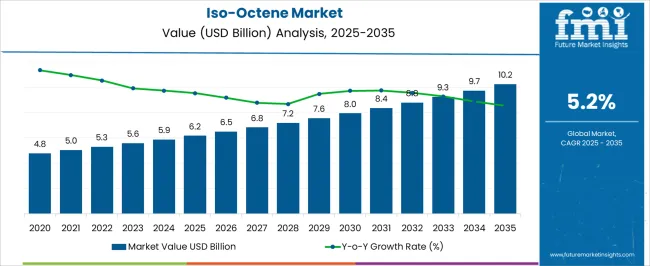
| Metric | Value |
|---|---|
| Iso-Octene Market Estimated Value in (2025 E) | USD 6.2 billion |
| Iso-Octene Market Forecast Value in (2035 F) | USD 10.2 billion |
| Forecast CAGR (2025 to 2035) | 5.2% |
The Iso-Octene market is experiencing steady growth driven by its pivotal role in the production of high-value chemicals and fuel additives. The current market scenario reflects increasing adoption of Iso-Octene as a critical building block for chemical intermediates, lubricants, and specialty polymers. Growth is being supported by rising demand from downstream chemical sectors where high-purity branched olefins are required for the synthesis of advanced resins, coatings, and performance fuels.
The market is being shaped by technological advancements in catalytic processes and the optimization of production efficiency, which reduce costs and enhance product quality. Increasing investments in chemical manufacturing infrastructure in both developed and emerging economies are further supporting market expansion.
Environmental regulations and the push for cleaner, high-octane fuels are creating opportunities for Iso-Octene to replace conventional linear alkenes in certain formulations The future outlook is positive, with continued demand expected from the chemicals sector and applications requiring high-performance intermediates, ensuring sustained market growth over the next decade.
The iso-octene market is segmented by functions, end use, and geographic regions. By functions, iso-octene market is divided into Chemical Intermediates and Additives. In terms of end use, iso-octene market is classified into Chemicals, Oil & Gas, and Others. Regionally, the iso-octene industry is classified into North America, Latin America, Western Europe, Eastern Europe, Balkan & Baltic Countries, Russia & Belarus, Central Asia, East Asia, South Asia & Pacific, and the Middle East & Africa.
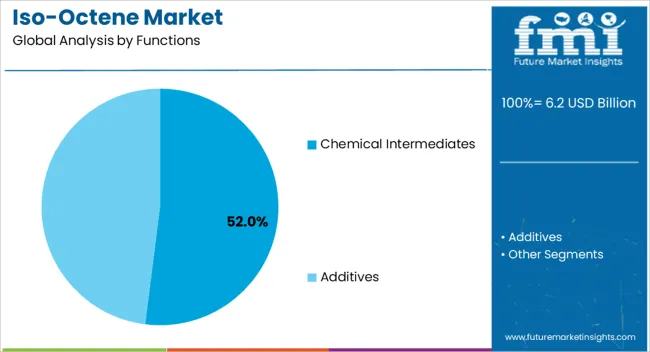
The Chemical Intermediates function segment is projected to hold 52.00% of the Iso-Octene market revenue share in 2025, making it the leading functional application. This dominance is being attributed to the extensive use of Iso-Octene as a feedstock for specialty chemicals, where purity and molecular structure are critical. Adoption has been accelerated by its role in producing high-value derivatives that enhance fuel performance, polymer quality, and additive efficiency.
The segment benefits from consistent demand across various chemical production processes, where Iso-Octene enables improvements in stability, performance, and energy efficiency. Growth is being reinforced by ongoing investments in chemical manufacturing plants, as well as by the increasing integration of Iso-Octene into formulations that require branched chain olefins for advanced performance characteristics.
The ability to modify downstream products without changing upstream processes has further strengthened its position, allowing manufacturers to maintain flexibility while meeting evolving market requirements The Chemical Intermediates segment is expected to continue leading due to these structural advantages and its central role in high-value chemical production.
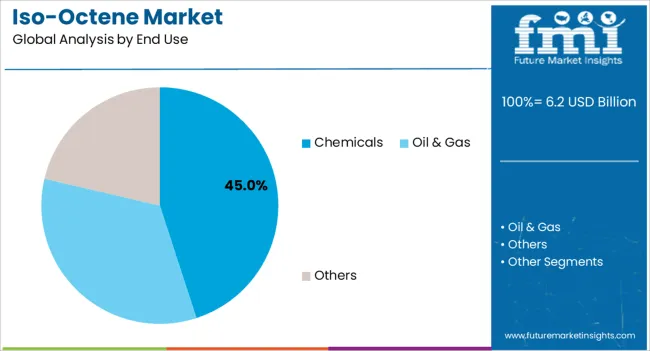
The Chemicals end-use segment is expected to account for 45.00% of the Iso-Octene market revenue share in 2025, positioning it as the largest end-use category. This leadership is being driven by the increasing demand for Iso-Octene in the production of high-octane fuels, lubricants, and specialty polymers where performance and stability are critical. Adoption has been accelerated by its compatibility with advanced chemical processes that produce additives and resins with superior properties.
Regulatory requirements for cleaner fuels and higher efficiency chemicals have further reinforced demand in this segment, making Iso-Octene a preferred choice among manufacturers. The segment benefits from both emerging market expansions and established industrial supply chains that facilitate consistent integration of Iso-Octene into production processes.
Moreover, the flexibility of Iso-Octene to enhance product quality while maintaining cost-effectiveness has encouraged large-scale adoption in chemicals manufacturing Sustained investment in refining and chemical infrastructure, coupled with the continued need for high-performance additives, is expected to maintain the dominance of the Chemicals end-use segment in the coming years.
Iso-octene is a chemical compound that is stable, colorless, and organic. It is widely used as a raw material in a variety of industries for the synthesis of fine chemicals such as octyldiphenylamine, octylphenol, isodecyl alcohol, and octylamine. During the dimerization of isobutylene, some n-butylene molecules react with isobutylene, resulting in the formation of dimer compounds. Iso-octene refers to the dimer compounds that have a di-isobutylene structure. It has a higher octane number, close to that of MTBE, a gasoline additive.
The olefinic nature of this chemical compound, on the other hand, is a major concern because it causes hydrogenation, which results in the formation of iso-octane. Furthermore, isobutylene dimerization produces tetradecene, trimeric dodecene, and pentapoly in addition to iso-octene. Iso-octane, which is produced by hydrogenating iso-octene, can be used as a fuel additive and chemical intermediate. The benefits of iso-octene and iso-octane include, among other things, the absence of sulphur, the absence of olefin, the absence of aroma, and the low vapor pressure, which is why these compounds are used as MTBE substitutes.
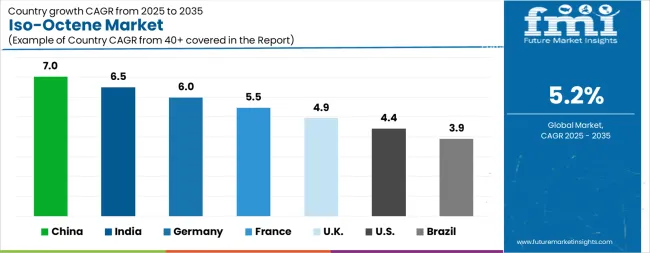
| Country | CAGR |
|---|---|
| China | 7.0% |
| India | 6.5% |
| Germany | 6.0% |
| France | 5.5% |
| UK | 4.9% |
| USA | 4.4% |
| Brazil | 3.9% |
The Iso-Octene Market is expected to register a CAGR of 5.2% during the forecast period, exhibiting varied country level momentum. China leads with the highest CAGR of 7.0%, followed by India at 6.5%. Developed markets such as Germany, France, and the UK continue to expand steadily, while the USA is likely to grow at consistent rates. Brazil posts the lowest CAGR at 3.9%, yet still underscores a broadly positive trajectory for the global Iso-Octene Market. In 2024, Germany held a dominant revenue in the Western Europe market and is expected to grow with a CAGR of 6.0%. The USA Iso-Octene Market is estimated to be valued at USD 2.1 billion in 2025 and is anticipated to reach a valuation of USD 3.3 billion by 2035. Sales are projected to rise at a CAGR of 4.4% over the forecast period between 2025 and 2035. While Japan and South Korea markets are estimated to be valued at USD 316.4 million and USD 194.0 million respectively in 2025.
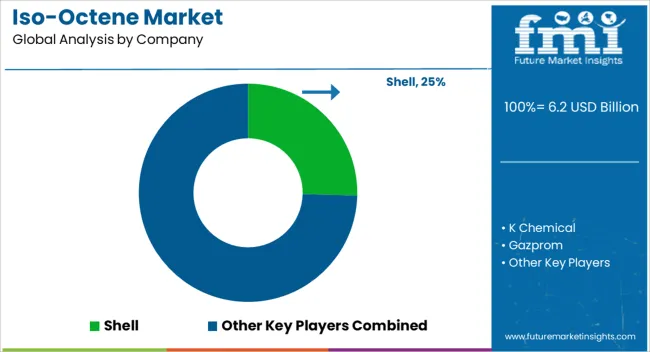
| Item | Value |
|---|---|
| Quantitative Units | USD 6.2 Billion |
| Functions | Chemical Intermediates and Additives |
| End Use | Chemicals, Oil & Gas, and Others |
| Regions Covered | North America, Europe, Asia-Pacific, Latin America, Middle East & Africa |
| Country Covered | United States, Canada, Germany, France, United Kingdom, China, Japan, India, Brazil, South Africa |
| Key Companies Profiled | Shell, K Chemical, Gazprom, Borealis, PBF Energy, Phillips 66, Rosneft, BP, ExxonMobil, LyondellBasell, Chevron Phillips Chemical Company, Marathon Petroleum, Flint Hills Resources, TotalEnergies, and Valero Energy |
The global iso-octene market is estimated to be valued at USD 6.2 billion in 2025.
The market size for the iso-octene market is projected to reach USD 10.2 billion by 2035.
The iso-octene market is expected to grow at a 5.2% CAGR between 2025 and 2035.
The key product types in iso-octene market are chemical intermediates and additives.
In terms of end use, chemicals segment to command 45.0% share in the iso-octene market in 2025.






Our Research Products

The "Full Research Suite" delivers actionable market intel, deep dives on markets or technologies, so clients act faster, cut risk, and unlock growth.

The Leaderboard benchmarks and ranks top vendors, classifying them as Established Leaders, Leading Challengers, or Disruptors & Challengers.

Locates where complements amplify value and substitutes erode it, forecasting net impact by horizon

We deliver granular, decision-grade intel: market sizing, 5-year forecasts, pricing, adoption, usage, revenue, and operational KPIs—plus competitor tracking, regulation, and value chains—across 60 countries broadly.

Spot the shifts before they hit your P&L. We track inflection points, adoption curves, pricing moves, and ecosystem plays to show where demand is heading, why it is changing, and what to do next across high-growth markets and disruptive tech

Real-time reads of user behavior. We track shifting priorities, perceptions of today’s and next-gen services, and provider experience, then pace how fast tech moves from trial to adoption, blending buyer, consumer, and channel inputs with social signals (#WhySwitch, #UX).

Partner with our analyst team to build a custom report designed around your business priorities. From analysing market trends to assessing competitors or crafting bespoke datasets, we tailor insights to your needs.
Supplier Intelligence
Discovery & Profiling
Capacity & Footprint
Performance & Risk
Compliance & Governance
Commercial Readiness
Who Supplies Whom
Scorecards & Shortlists
Playbooks & Docs
Category Intelligence
Definition & Scope
Demand & Use Cases
Cost Drivers
Market Structure
Supply Chain Map
Trade & Policy
Operating Norms
Deliverables
Buyer Intelligence
Account Basics
Spend & Scope
Procurement Model
Vendor Requirements
Terms & Policies
Entry Strategy
Pain Points & Triggers
Outputs
Pricing Analysis
Benchmarks
Trends
Should-Cost
Indexation
Landed Cost
Commercial Terms
Deliverables
Brand Analysis
Positioning & Value Prop
Share & Presence
Customer Evidence
Go-to-Market
Digital & Reputation
Compliance & Trust
KPIs & Gaps
Outputs
Full Research Suite comprises of:
Market outlook & trends analysis
Interviews & case studies
Strategic recommendations
Vendor profiles & capabilities analysis
5-year forecasts
8 regions and 60+ country-level data splits
Market segment data splits
12 months of continuous data updates
DELIVERED AS:
PDF EXCEL ONLINE

Thank you!
You will receive an email from our Business Development Manager. Please be sure to check your SPAM/JUNK folder too.
Chat With
MaRIA